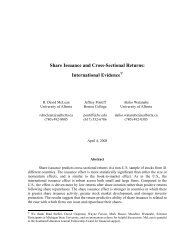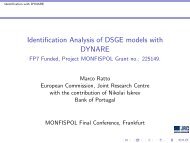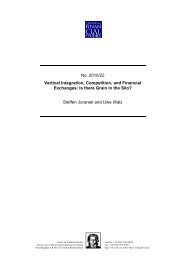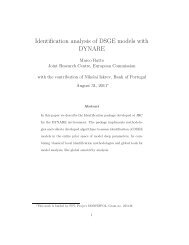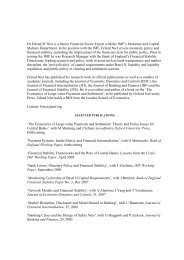Forecasting and Policy Making (Paper) - Center for Financial Studies
Forecasting and Policy Making (Paper) - Center for Financial Studies
Forecasting and Policy Making (Paper) - Center for Financial Studies
Create successful ePaper yourself
Turn your PDF publications into a flip-book with our unique Google optimized e-Paper software.
(iv) large-scale structural macro-econometric models.<br />
We will show how to employ structural models <strong>for</strong> identifying the sources of predicted dynamics<br />
of key macroeconomic variables. They allow <strong>for</strong> an instructive interpretation of <strong>for</strong>ecasts. Since<br />
central banks often condition <strong>for</strong>ecasts on exogenous paths of future monetary <strong>and</strong> fiscal policy, we<br />
will discuss <strong>and</strong> implement several different assumptions used at central banks <strong>and</strong> illustrate two<br />
alternative methods <strong>for</strong> computing such <strong>for</strong>ecasts. Furthermore, we will show how these methods can<br />
be used to include judgement in model-based <strong>for</strong>ecasts <strong>and</strong> how to incorporate a particular nonlinearity<br />
that is great importance in current <strong>for</strong>ecasts, that is the zero-lower-bound on nominal interest rates.<br />
We use the term ”structural” to mean that model equations <strong>and</strong> parameters have an economic in-<br />
terpretation that imposes particular parametric restrictions on the <strong>for</strong>ecast relative to the non-structural<br />
VAR models of the preceding subsection. Furthermore, the term ”New Keynesian” refers to models<br />
that include explicit nominal rigidities, such as <strong>for</strong> example wage <strong>and</strong> price contracts, rational expecta-<br />
tions of market participants <strong>and</strong> monetary policy rules. In particular, the latter two features distinguish<br />
these models from more traditional Keynesian-style models with purely backward-looking dynamics.<br />
Within the class of New-Keynesian models we find it helpful to distinguish between a first generation<br />
of the type of models with rational expectations <strong>and</strong> nominal rigidities published from the late 1970s<br />
to the early 1990s. In these models behavioral equations are often inspired by the decision rules of<br />
optimizing agents but they are not exclusively derived from optimization problems of households <strong>and</strong><br />
firms. By contrast, the second generation of New Keynesian models published from the late 1990s<br />
onwards explicitly implements all restrictions resulting from optimizing behavior of households <strong>and</strong><br />
firms subject to concretely specified constraints. They are typically referred to as New Keynesian<br />
DSGE models. 27<br />
A well known advantage of structural models with rational expectations <strong>and</strong> microeconomic foun-<br />
dations is that they enable modelers <strong>and</strong> <strong>for</strong>ecasters to account <strong>for</strong> the Lucas critique, which empha-<br />
sizes that market participants’ expectations <strong>and</strong> decision-making changes in response to systematic<br />
changes in policy making. Thus, such models are particularly useful <strong>for</strong> counterfactual policy sim-<br />
ulations <strong>and</strong> analysis following policy regime changes such as the change of policy strategy or the<br />
<strong>for</strong>mation of a monetary union.<br />
5.1 Non-structural time series models<br />
Nowcasting<br />
Given that macroeconomic data only become available with some time lag, the first important<br />
step in any <strong>for</strong>ecasting exercise is to estimate the currently prevailing state of the economy. This<br />
estimate is commonly referred to as the nowcast. To give an example, the first releasse of U.S. GDP<br />
is published late in the first month following the quarter it refers to <strong>and</strong> updated releases are published<br />
subsequently. Rather than relying only on GDP numbers from earlier quarters, central banks typically<br />
27 For detailed descriptions of models of these different types see <strong>for</strong> example Taylor <strong>and</strong> Wiel<strong>and</strong> (2011) <strong>and</strong> Schmidt<br />
<strong>and</strong> Wiel<strong>and</strong> (2012, in preparation).<br />
32



